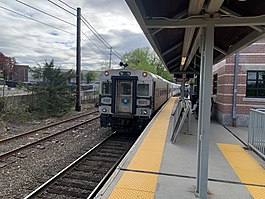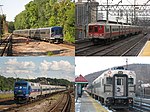
Metro-North Railroad, trading as MTA Metro-North Railroad, is a suburban commuter rail agency run by the Metropolitan Transportation Authority (MTA), a public authority of the U.S. state of New York and under contract with the Connecticut Department of Transportation. Metro-North serves the New York Metropolitan Area, running service between New York City and its northern suburbs in New York and Connecticut, including Port Jervis, Spring Valley, Poughkeepsie, Yonkers, New Rochelle, Mount Vernon, White Plains, Southeast and Wassaic in New York and Stamford, New Canaan, Danbury, Bridgeport, Waterbury, and New Haven in Connecticut. Metro-North also provides local rail service within the New York City boroughs of Manhattan and the Bronx.
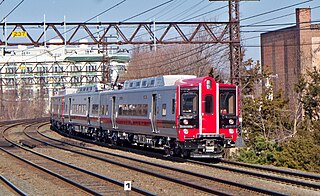
The New Haven Line is a 72.7 mi (117.0 km) commuter rail line operated by the Metro-North Railroad in the U.S. states of New York and Connecticut. Running from New Haven, Connecticut, to New York City, the New Haven Line joins the Harlem Line in Mount Vernon, New York, and continues south to Grand Central Terminal in Manhattan. The New Haven Line carries 125,000 passengers every weekday and 39 million passengers a year. The busiest intermediate station is Stamford, with 8.4 million passengers, or 21% of the line's ridership.

The Housatonic Railroad is a Class III railroad operating in southwestern New England and eastern New York. It was chartered in 1983 to operate a short section of ex-New York, New Haven and Hartford Railroad in northwestern Connecticut, and has since expanded north and south, as well as west into New York State.

The Danbury and Norwalk Railroad, chartered in 1835 as the Fairfield County Railroad, was an independent American railroad that operated between the cities of Danbury and Norwalk, Connecticut from 1852 until its absorption by the Housatonic Railroad in 1886. The right of way established by the D&N continues in operation and is now the Danbury Branch of the New Haven Line of the Metro-North Railroad.

Danbury station is a commuter rail station on the Danbury Branch of the Metro-North Railroad's New Haven Line, located in Danbury, Connecticut. The station is the northern terminus of Danbury Branch. The station is also a hub for Housatonic Area Regional Transit.

South Norwalk station is a commuter rail stop on the Metro-North Railroad's New Haven Line and CTrail's Shore Line East located in Norwalk, Connecticut. It is owned and managed by the Norwalk Transit District. The station is the point where the New Haven Line's Danbury Branch connects to the Northeast Corridor, as well as a peak-hour terminal for some express trains. It is the last stop for New Haven super-express trains before they run non-stop to Grand Central Terminal in New York. Just east of the station is the South Norwalk Railroad Bridge, and next to that is the SoNo Switch Tower Museum, a preserved switch tower which is open on summer weekend afternoons. Amtrak uses the inner tracks as it does not stop at South Norwalk.

Bethel station is a commuter rail station on the Danbury Branch of the Metro-North Railroad New Haven Line, located in Bethel, Connecticut.
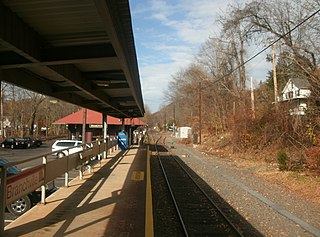
Branchville station is a commuter rail station on the Danbury Branch of the Metro-North Railroad New Haven Line, located in the Branchville neighborhood of Ridgefield, Connecticut.
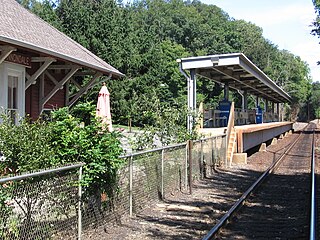
Cannondale station is a commuter rail station on the Danbury Branch of the Metro-North Railroad's New Haven Line, located in the Cannondale neighborhood of Wilton, Connecticut. The station building was added to the National Register of Historic Places in 1992 as part of the Cannondale Historic District.

Wilton station is a commuter rail station on the Danbury Branch of the Metro-North Railroad's New Haven Line, located in Wilton, Connecticut. The station first opened in 1852 and is the most used station on the Danbury Branch by weekday passengers.

Bridgeport-Stamford-Norwalk is a metropolitan area in the U.S. state of Connecticut. The area is located in Southwestern Connecticut. In its most conservative form the area consists of the city of Bridgeport and five surrounding towns—Easton, Fairfield, Monroe, Stratford, and Trumbull. This definition of the Bridgeport area has a population of more than 305,000 and is within the Bridgeport-Stamford-Norwalk-Danbury metropolitan statistical area, which consists of all of Fairfield County, Connecticut. The estimated 2015 county population was 948,053. The area is numbered as part of the New York-Newark Combined Statistical Area NY-NJ-CT-PA by the United States Census Bureau.
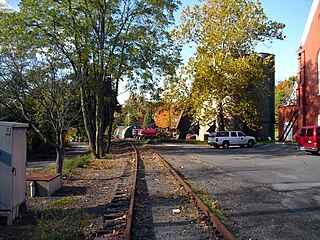
The Metro-North Railroad's Beacon Line is a non-revenue line connecting the railroad's three revenue lines east of the Hudson River. From west to east, the lines that connect are Hudson Line, Harlem Line, and the Danbury Branch of the New Haven Line. It was purchased by Metro-North in 1995 for $4.2 million from Maybrook Properties, a subsidiary of the Housatonic Railroad, to preserve it for future use, training, and equipment moves. Maybrook Properties purchased the line from Conrail after Conrail withdrew from the Danbury, Connecticut, freight market in 1992.

The Shepaug, Litchfield and Northern Railroad was a short independent railroad in western Connecticut that was chartered as the Shepaug Valley Railroad in 1868 and operated from 1872 to 1891 when it was taken over by the Housatonic Railroad. In 1898, the Housatonic operation was assumed by the New York, New Haven & Hartford Railroad (NH). As the Litchfield Division of the NH, the line was operated until abandonment in 1948. Much of the line remains as a rail trail.

The Housatonic Railroad was a railroad in the U.S. states of Connecticut and Massachusetts, chartered in 1836. Opened between Bridgeport, Connecticut, and New Milford, Connecticut, in 1840, it was completed to a connection with the Western Railroad in West Stockbridge, Massachusetts, in 1842. Branches were later built to Pittsfield, Massachusetts, Danbury, Connecticut, and Derby, Connecticut, the latter as part of the Housatonic Railroad's purchase of the New Haven and Derby Railroad in 1887.

New Milford station is a former railroad station on Railroad Street in New Milford, Connecticut. Built in 1886 by the Housatonic Railroad Company, it cemented the town's importance as a regional tourist and business center. It served passenger service until 1971, and is now home to the Greater New Milford chamber of commerce. It was listed on the National Register of Historic Places in 1984.
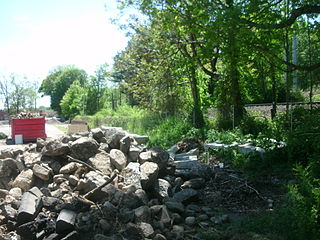
Kent Road station was a commuter rail stop on the Danbury Branch of the Metro-North Railroad's New Haven Line. It was located near the border between Wilton and Norwalk, south of a grade crossing with Kent Road in Wilton, Connecticut. It opened in 1976 and closed in 1994. A previous station on the site, South Wilton, closed in 1971.

Brookfield station is a proposed passenger rail station on the Danbury Branch of the Metro-North Railroad New Haven Line, to be located in Brookfield, Connecticut.
The Berkshire was a New York, New Haven and Hartford Railroad named train running from New York City's Grand Central Terminal to Pittsfield, Massachusetts. It was the longest-running north–south train in Litchfield Hills of western Connecticut and the Berkshires of Massachusetts. From New York City it followed the New Haven Line to South Norwalk, the Danbury Line to Danbury and the Berkshire Division to Pittsfield. It began in the 1940s and ran until 1968. The train was preceded by the Berkshire Express, of c.1938-c.1943. It terminated at Pittsfield Union Station until 1960, when the New Haven moved it to another station in the city.

The Ridgefield Branch was a branch line of the Danbury and Norwalk Railroad and later the New York, New Haven and Hartford Railroad. It ran for 4.0 miles (6.4 km) from Branchville to the center of Ridgefield, Connecticut. After a difficult and costly construction hindered by the topography of the Norwalk River valley, the branch opened in July 1870 after a year of construction. Throughout its existence, three stations existed on the line. In 1925, amid electrification of the neighboring Danbury Line, passenger service on the branch was terminated. Freight service continued to just the Ridgefield station until 1964, when the line was abandoned entirely.
